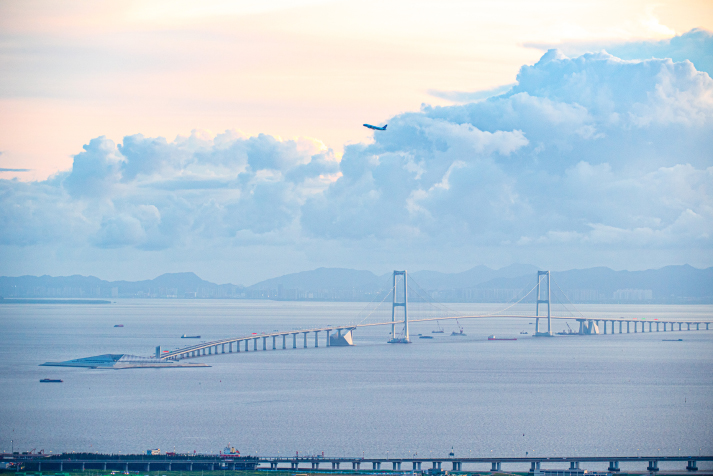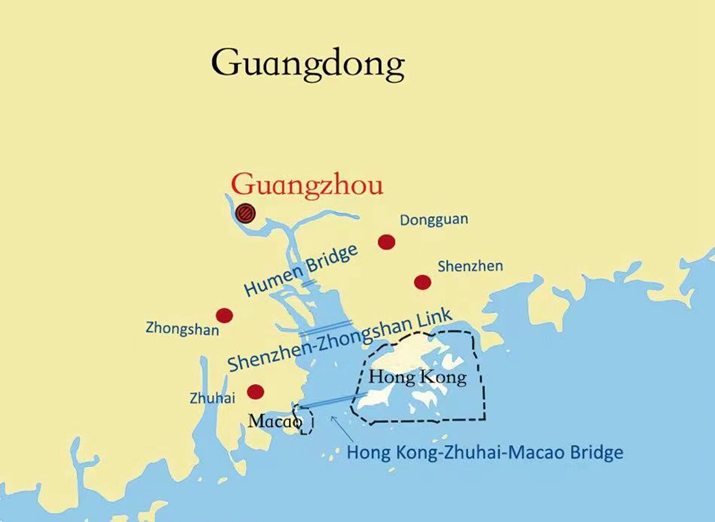| China |
| Shenzhen-Zhongshan cross-sea passage begins trial operation | |
|
|
 The Shenzhen-Zhongshan Link in the Pearl River Estuary in south China, on June 23 (XINHUA)
As one of the best-known freshwater fish produced in Zhongshan City in the southern Chinese province of Guangdong, crispy grass carp is widely favored for its savory flavor, as well as for the firm and springy texture that gives it its name. The culinary preferences of Guangdong natives hinge upon the concept of freshness. As dozens of refrigerated trucks, laden with the fish, cross the bay between Zhongshan and Shenzhen cities in Guangdong daily, the transit time and journey length dictate the value of this delicacy. For gourmands in Shenzhen, enjoying Zhongshan's crispy grass carp at its very freshest depends on the strength of the region's transport infrastructure. The mouth of the Pearl River Estuary forms an inverted V-shaped bay. Setting off from Zhongshan on the western side to reach Shenzhen on the opposite side used to necessitate a detour around the top of the bay and across the Humen Bridge in Dongguan City. A straight-line distance of around 20 km became a nearly 100-km journey by road, taking approximately two hours. However, the 24-km Shenzhen-Zhongshan Link, which opened to traffic at 3 p.m. on June 30, drastically reduces travel time between the cross-bay neighbors to around 30 minutes. This is great news for lovers of crispy grass carp, but also for many others. The mega cross-sea passage, featuring two bridges, two artificial islands and an underwater tunnel, is a strategic link in the Guangdong-Hong Kong-Macao Greater Bay Area (GBA) connecting the eastern and western sides of the Pearl River Estuary. Covering 56,000 square km and with a population exceeding 86 million, the GBA consists of Hong Kong and Macao special administrative regions, and nine cities—Guangzhou, Shenzhen, Zhuhai, Foshan, Huizhou, Dongguan, Zhongshan, Jiangmen and Zhaoqing—in Guangdong. The regional economic output exceeded 14 trillion yuan (around $1.96 trillion) in 2023. China aims to develop the area into a world-class city cluster, a global technology and innovation center, and a livable, business-friendly destination. Data from the Guangdong Transportation Group showed 305,000 vehicles used the new passage in the first 72 hours after it opened to traffic. The link had already accounted for about 25 percent of the daily traffic passing across the Pearl River, according to the Guangdong Provincial Department of Transport. The magic of transportation The Shenzhen-Zhongshan Link is one of the GBA's many large-scale transportation projects that have followed the construction of the 55-km Hong Kong-Zhuhai-Macao Bridge, which opened in October 2018 and is the longest bridge-and-tunnel sea crossing in the world. It is located about 30 km south of the Humen Bridge and 31 km north of the Hong Kong-Zhuhai-Macao Bridge. With an estimated cost of 44.69 billion yuan ($6.14 billion), the link features eight lanes designed for speeds of up to 100 km per hour, with a toll of 66 yuan ($9) for vehicles utilizing the route. It is considered to be one of the world's most challenging cross-sea cluster projects to have been built. Over 10,000 workers overcame obstacles such as frequent typhoons, high salinity, humidity and severe siltation during the seven-year course of its construction. The project additionally managed to overcome multiple world-class technical challenges and set multiple world records in areas such as suspension bridge engineering, tunnel construction and underwater highway interchanges. For example it is the world's first long-distance, dual eight-lane, submarine tunnel that uses immersed tubes, segments of tunnel that are constructed elsewhere, floated to the site and sunk into position. It also has the world's longest and widest underwater steel-shell concrete immersed-tube tunnel, with an immersed tube section of about 5 km. At present, key passages such as the Hong Kong-Zhuhai-Macao Bridge, Humen Bridge and Nansha Bridge have been built on both sides of the Pearl River Estuary. Along with the newly opened Shenzhen-Zhongshan Link and the under-construction Shiziyang Channel, they collectively form the GBA's cross-river and cross-sea passages, enhancing connectivity among the cities in the GBA. The Shiziyang Channel, stretching from Guangzhou's Nansha District to Humen Town in Dongguan, is scheduled to be completed and put into use in 2028.  An illustration showing the locations of cities surrounding and projects crossing the Pearl River Estuary (HE MINTING)
Wider impacts In recent years, Guangdong has continued to enhance the integrated development of the Pearl River Estuary's eastern and western sides, which is also a driver to boost the high-quality development of the GBA. The province is working to create a "Golden Inner Bay" that spans 100 km around the Pearl River Estuary. This initiative is expected to catalyze the synergistic evolution of the three prominent metropolitan circles of Guangzhou, Shenzhen, and the western bank of the estuary. The western bank is usually seen as less developed than the eastern bank. For instance, the combined GDP of Shenzhen, Dongguan and Huizhou on the eastern bank was approximately 4.9 trillion yuan ($673 billion) in 2022, while the aggregate of Zhuhai, Zhongshan and Jiangmen on the western bank was around 1.1 trillion yuan ($151.23 billion) that year. The opening of the Shenzhen-Zhongshan Link improves connectivity between these two sides and significantly increases the value of the "Golden Inner Bay" around the Pearl River Estuary. "The opening of the Shenzhen-Zhongshan Link will reshape the road network layout of the Pearl River Estuary, significantly impacting the economic and social development of the GBA," Lin Feiming, head of the Guangdong Provincial Department of Transport, told Xinhua News Agency. Chen Chi, a researcher at the Counsellors' Office of Guangdong Provincial Government, said at a recent seminar on the Shenzhen-Zhongshan Link in Guangzhou that the link will further boost linkage among cities such as Shenzhen, Zhongshan, Guangzhou and Jiangmen, thereby further unleashing the development potential of the GBA. He said he believes, with the opening of the link, the cities can seize the opportunity to open up the markets of production factors including land, labor and capital, channel the innovation resources of Guangzhou, Shenzhen and Hong Kong to bear fruit on the western bank of the Pearl River Estuary, and contribute to building an innovative GBA. With the continuous deepening of the integration process in the future, the GBA is expected to become a de facto "super city," thus realizing further specialization of industrial division, and further improving the efficiency of innovative economic development, as well as the international competitiveness and influence of the GBA, according to Chen. The new link will enhance regional development and competitiveness, bridging the economic gap between the eastern and western sides of the Pearl River Estuary and facilitating leisure travel, according to a Xinhua report. "The eastern bank excels in advanced manufacturing and technological innovation but faces space limitations and rising costs. The western bank, on the other hand, aspires industrial transformation and upgrading to boost its economic vitality," the report reads. (Print Edition Title: Linking the Bay) Copyedited by G.P. Wilson Comments to taoxing@cicgamericas.com |
|
||||||||||||||||||||||||||||
|